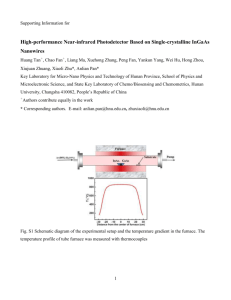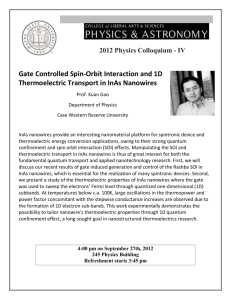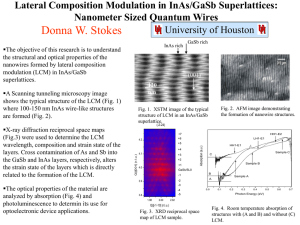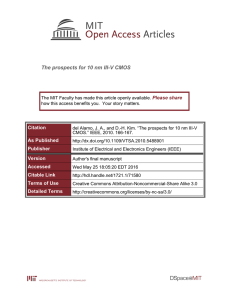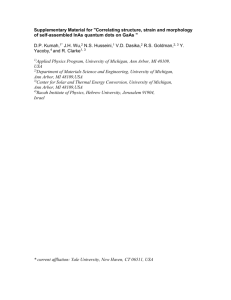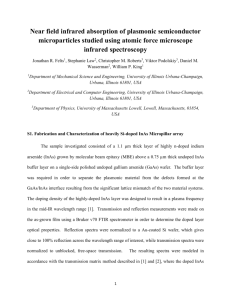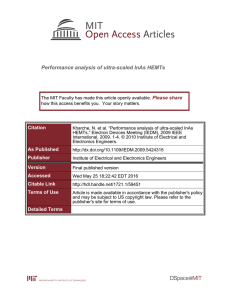Scalability of Sub-100 nm InAs HEMTs on InP Substrate Please share
advertisement
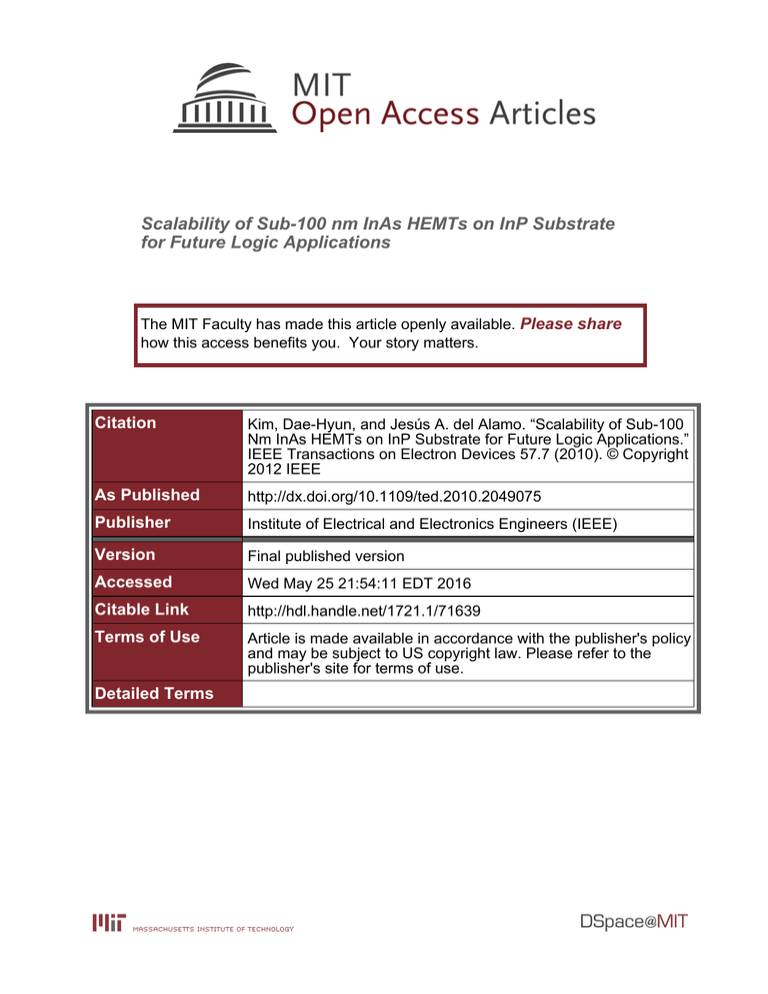
Scalability of Sub-100 nm InAs HEMTs on InP Substrate for Future Logic Applications The MIT Faculty has made this article openly available. Please share how this access benefits you. Your story matters. Citation Kim, Dae-Hyun, and Jesús A. del Alamo. “Scalability of Sub-100 Nm InAs HEMTs on InP Substrate for Future Logic Applications.” IEEE Transactions on Electron Devices 57.7 (2010). © Copyright 2012 IEEE As Published http://dx.doi.org/10.1109/ted.2010.2049075 Publisher Institute of Electrical and Electronics Engineers (IEEE) Version Final published version Accessed Wed May 25 21:54:11 EDT 2016 Citable Link http://hdl.handle.net/1721.1/71639 Terms of Use Article is made available in accordance with the publisher's policy and may be subject to US copyright law. Please refer to the publisher's site for terms of use. Detailed Terms 1504 IEEE TRANSACTIONS ON ELECTRON DEVICES, VOL. 57, NO. 7, JULY 2010 Scalability of Sub-100 nm InAs HEMTs on InP Substrate for Future Logic Applications Dae-Hyun Kim and Jesús A. del Alamo, Fellow, IEEE Abstract—We have experimentally studied the scaling behavior of sub-100-nm InAs high-electron mobility transistors (HEMTs) on InP substrate from the logic operation point of view. These devices have been designed for scalability and combine a thin InAlAs barrier and a thin channel containing a pure InAs subchannel. InAs HEMTs with gate length down to 40 nm exhibit excellent logic figures of merit, such as ION /IOFF = 9 × 104 , drain-induced-barrier lowering = 80 mV/V, S = 70 mV/dec, and an estimated logic gate delay of 0.6 ps at VD S = 0.5 V. In addition, we have obtained excellent high-frequency operation with Lg = 40 nm, such as fT = 491 GHz and fmax = 402 GHz at VD S = 0.5 V. In spite of the narrow bandgap of InAs subchannel, under the studied conditions, our devices are shown not to suffer from excessive band-to-band tunneling. When benchmarked against state-of-the-art Si devices, 40-nm InAs HEMTs exhibit ION = 0.6 A/μm at ILeak = 200 nA/μm. This is about two times higher ION than state-of-the-art high-performance 65-nm nMOSFET with comparable physical gate length and ILeak . Index Terms—Drain-induced barrier lowering (DIBL), gate delay, high-electron mobility transistor (HEMT), InAs, ION /IOFF , logic, scaling, subthreshold swing. I. I NTRODUCTION I II–V compound semiconductors have recently emerged as a promising choice for channel material of future post-Si CMOS logic transistors. This is due to their outstanding electron transport properties, their relative maturity, and demonstrated reliability when compared with other candidates, such as carbon nanotube transistors and semiconductor nanowires [1]–[5]. For future III–V based field-effect transistors (FETs) to enter the CMOS roadmap, they will have to have dimensions compatible with the 22 nm CMOS node or beyond. As such, scalability is of critical importance. Future III–V FETs are likely to integrate a high-k dielectric in the gate stack and a self-aligned architecture [6]–[9]. There are several challenges to overcome before this can be accomplished [10]–[12]. In the meantime, the scalability of III–V Manuscript received August 26, 2009; revised April 6, 2010; accepted April 8, 2010. Date of current version June 23, 2010. This work was supported in part by Intel Corporation and in part by the Focus Center Research Program on Material, Structures and Devices, Massachusetts Institute of Technology. The work of D.-H. Kim was supported by the Korean Research Foundation Fellowship under Contract KRF-2004-214-D00327. The review of this paper was arranged by Editor M. Anwar. D.-H. Kim was with Microsystems Technology Laboratory, Massachusetts Institute of Technology. He is now with Teledyne Scientific Company, Thousand Oaks, CA 91360 USA. J. A. del Alamo is with the Department of Electrical Engineering and Computer Science, Massachusetts Institute of Technology, Cambridge, MA 02139 USA. Color versions of one or more of the figures in this paper are available online at http://ieeexplore.ieee.org. Digital Object Identifier 10.1109/TED.2010.2049075 FETs can be studied using high-electron mobility transistors (HEMTs). These are useful devices in their own right for millimeter-wave applications, but they can also constitute an excellent model system to study issues of critical importance of future III–V MOSFETs, such as intrinsic carrier transport, quantum capacitance, band-to-band tunneling (BTBT), impact ionization, and the impact of parasitic resistances onto device performance. Recent research on InAlAs/InGaAs HEMTs has demonstrated that these devices exhibit excellent logic characteristics down to about 60 nm [13]. This has been accomplished by thinning down the InAlAs barrier (tins ) to the 3–4 nm range. Further lateral scaling is going to require scaling of the channel thickness (tch ) as well. However, as tch scales down, carrier transport in the channel deteriorates, mainly as a consequence of the increased carrier scattering mechanisms [14], [15]. In this paper, we have explored a solution to this problem through the introduction of a pure thin layer of InAs in the channel [16], [17]. InAs is a very attractive material with an electron mobility as high as 20 000 cm2 /V · s at room temperature. The introduction of InAs is expected to mitigate the deleterious effects of channel thickness scaling. We show that it is possible to fabricate devices with a channel thickness of 10 nm while keeping excellent carrier transport in the channel. In this way, we demonstrate HEMT scalability down to the 40-nm gate length regime. This paper represents an augmented and updated version of an earlier conference presentation [18]. It describes the detailed fabrication process of the InAs HEMTs with a 10-nm channel thickness on InP substrate. In addition, we present the logic characteristics of the fabricated InAs HEMTs as a function of gate length (Lg ) and barrier thickness (tins ), and we compare them to our prior work with a thicker channel (tch = 13 nm) [13]. Finally, we benchmark our fabricated InAs HEMTs against state-of-the-art Si CMOS. A significant finding in this work is that in spite of the narrow bandgap of the InAs subchannel, these devices do not suffer from excessive BTBT. II. D EVICE T ECHNOLOGY Fig. 1 shows the epitaxial layer structure utilized in this work. This is grown by molecular beam epitaxy (MBE) on a semi-insulating InP substrate. In essence, this is an InAlAs/ InGaAs HEMT structure with a composite channel that includes a strained InAs subchannel. Except for the channel structure, the device layer design is similar to our previous work [13]. The layers consist of, from bottom to top, a 500-nm In0.52 Al0.48 As buffer, a 10-nm composite channel (described in more detail next), a 3-nm In0.52 Al0.48 As spacer, a Si δ-doping 0018-9383/$26.00 © 2010 IEEE KIM AND DEL ALAMO: SCALABILITY OF InAs HEMTs ON InP SUBSTRATE FOR FUTURE LOGIC APPLICATIONS Fig. 1. work. MBE-grown epitaxial layer structure of InAs HEMTs used in this (5 × 1012 /cm2 ), an 8-nm In0.52 Al0.48 As barrier, a 6-nm InP etch-stopper, a 15-nm n+ doped In0.52 Al0.48 As subcap, a 25-nm n+ doped In0.53 Ga0.47 As subcap, and a 10-nm n+ doped In0.65 Ga0.35 As subcap. The channel consists of a trilayer of In0.53 Ga0.47 As, InAs, and In0.53 Ga0.47 As of thicknesses, from bottom to top, 3, 5, and 2 nm. Altogether, this is about 30% thinner than our previous In0.7 Ga0.3 As HEMT design [13]. In a Hall epi wafer that has the same structure as the device wafer but otherwise uses a simple 10-nm In0.53 Ga0.47 As cap with a Si doping density of 1 × 1018 cm−3 , the Hall mobility (μn,Hall ) and 2-D electron gas sheet carrier concentration (ns ) were measured to be around 13 200 cm2 /V · s and 2.9 × 1012 /cm2 at room temperature. The Hall mobility is about 30% higher than in our earlier In0.7 Ga0.3 As heterostructure [13], [19]. Device fabrication is very similar to our previous work [13], [19]. It began with mesa isolation using H3 PO4 -based wet etchant. This was followed by Ni/Ge/Au (10/45/150 nm) source and drain ohmic contacts with a 2-μm spacing and alloying at 320 ◦ C for 30 s in N2 ambient. E-beam lithography using a Reica-150 equipment was utilized to define T-shaped gates with various dimensions. We used a trilayer resist stack of ZEP-520A/PMGI/ZEP-520A (from bottom to top, 200/600/ 100 nm). To study the scaling behavior of this technology, different values of the gate length were defined by adjusting the e-beam dose and changing the layout dimension accordingly to keep the source–gate and gate–drain distances constant. Gate recessing was performance in three different stages, as in our earlier work [13]. First, an isotropic etching of the InGaAs/InAlAs multilayer cap was performed in the mixture of citric acid and H2 O2 (20 : 1). This was followed by anisotropic etching of InP layer using low-damaged Ar-based plasma. Finally, time-controlled wet etching of the InAlAs barrier using diluted citric acid solution was performed to further thin down the insulator thickness (tins ). We calibrated the depth of the remaining InAlAs barrier through scanning transmission electron microscope (STEM) inspection and obtained a tins of about 4 nm, as shown in Fig. 2(a) which corresponds to an Lg = 40 nm device. In addition, we made devices with thicker tins 1505 devices by omitting the third recess step. An insulator thickness of 10 nm was measured by STEM inspection, as shown in Fig. 2(b), which corresponds to an Lg = 45 nm device. This is slightly different from the MBE-grown nominal barrier thickness of 11 nm, probably as a result of the finite etching selectivity of InP against InAlAs during Ar-based plasma [20]. Finally, device fabrication was completed by the evaporation and lift-off of Ti/Pt/Au (20/20/300 nm) Schottky gate metal stack. Devices with various gate lengths were fabricated, from 340 nm down to 40 nm. Fig. 2(c) shows a STEM image of the cross section of a Lg = 45 nm T-gate device. Notice that the evaporated gate metal partially overlaps with the InP etchstopper at both edges of the InAlAs recessed region. As a result, the metallurgical Lg seems to be larger than 45 nm. However, we define Lg as the length of the recessed region in the InAlAs barrier as in the two-step recess process [21]. Fig. 2(c) also shows that the side-recess-spacing length (Lside ) in these devices was set to be around 200 nm to ensure optimum logic operation. This was done by adjusting the recess etching time of the InGaAs/InAlAs capping layers [22]. The source and drain spacing (LSD ) was 2 μm in these devices. Future III–V HFETs will require a scaling of LSD with Lg since a reduction in the device pitch is the main driving force for logic technology. III. R ESULTS Fig. 3 shows typical output characteristics of InAs HEMTs with (a) tins = 10 nm and (b) tins = 4 nm for various gate lengths. As in our previous work on In0.7 Ga0.3 As HEMTs [13], we find that thinner insulator devices exhibit better current driving capability and a more positive VT . They also show better scalability. Looking at output conductance (go ) for both types of 40 nm InAs HEMTs, we see that the devices with tins = 4 nm show slightly better output conductance than those with tins = 10 nm, which is a result of the reduction in tins . Improved short-channel effects (SCEs) that arise from a thinner insulator are evident in the subthreshold characteristics. Fig. 4 shows subthreshold characteristics of both types of 40 nm devices at VDS = 50 mV and 0.5 V, together with gate leakage current (IG ). Here, we can clearly see how the 4-nm barrier device exhibits superior subthreshold swing (S) and draininduced barrier lowering (DIBL, change in VT with VDS ). We also see that VT shifts positive as the barrier is thinned down. A tradeoff with scaling the insulator thickness that is evident in Fig. 4 is an increase of gate leakage current in the forward and reverse gate bias condition. A consequence of this is that the minimum subthreshold current is about an order of magnitude higher for the thin barrier device. It is interesting to note that in both types of devices, the minimum subthreshold current is dominated by Schottky gate leakage, not by band-to-bandtunneling (BTBT). This will be a serious concern when a high mobility channel material is utilized with a significantly smaller bandgap than Si and might ultimately limit the scalability of the device [23], [24]. In our device design, BTBT is not a significant concern in spite of the narrow bandgap of the channel. This might be due to electron quantization in the thin InAs 1506 IEEE TRANSACTIONS ON ELECTRON DEVICES, VOL. 57, NO. 7, JULY 2010 Fig. 2. STEM images of the cross section of the fabricated device. (a) Close up of gate region for an Lg = 40 nm and tins = 4 nm device. (b) Close up of gate region for tins = 10 nm device with Lg = 45 nm. (c) Gate view of an Lg = 45 nm gate length device showing Lside = 200 nm. Fig. 4. Subthreshold and gate current characteristics of 40-nm InAs HEMTs with tins = 10 nm (black) and tins = 4 nm (red), at VDS = 0.05 V and 0.5 V. Fig. 3. Output characteristics of InAs HEMTs with (a) tins = 10 nm and (b) tins = 4 nm for various values of Lg . subchannel layer, which is expected to enlarge the effective bandgap (Eg ) [25]. However, future device designs with much reduced gate leakage current might show more pronounced BTBT currents. The improvement in transistor performance with tins scaling can be seen more clearly in the transconductance (gm ) characteristics. Fig. 5 plots gm of both types of InAs HEMTs for various values of Lg at VDS = 0.5 V. For thicker barrier devices with tins = 10 nm [Fig. 5(a)], as Lg scales down, gm initially increases, and then, it actually gets worse beyond an Lg of about 60 nm. We can also see a significant negative shift in VT , as Lg scales down. These are clear indications of severe SCEs. On the contrary, tins = 4 nm devices [Fig. 5(b)] exhibit much less VT shift as Lg scales down. More importantly, the peak gm continues to scale gracefully down to Lg = 40 nm. In fact, the 40-nm InAs HEMTs with tins = 4 nm display an excellent value of gm,max > 2 mS/μm at VDS = 0.5 V. Fig. 6 summarizes gm,max as a function of Lg for both types of InAs HEMTs, as well as our previous In0.7 Ga0.3 As HEMTs with tins = 10 and tch = 13 nm [4]. This figure highlights the combined benefits of thin insulator, thin channel, and higher mobility channel. When compared with In0.7 Ga0.3 As HEMTs, the benefits of InAs HEMTs are now apparent. For a similar value of the barrier thickness (tins = 10 nm), the InAs HEMTs exhibit much higher values of gm,max at long KIM AND DEL ALAMO: SCALABILITY OF InAs HEMTs ON InP SUBSTRATE FOR FUTURE LOGIC APPLICATIONS 1507 ∗ as extracted by the gate current injection technique as a Fig. 7. Measured RS function of Lg for InAs HEMTs with tins = 4 nm and In0.7 Ga0.3 As HEMTs with tins = 3 nm. The extracted values of Rs for both devices are shown. Fig. 5. Transconductance characteristics of 40-nm InAs HEMTs with (a) tins = 10 nm and (b) tins = 4 nm, for various values of Lg , at VDS = 0.5 V. Fig. 6. Maximum transconductance (gm,max ) as a function of Lg for InAs HEMTs with tins = 10 nm (black) and tins = 4 nm (red). Our previous results on In0.7 Ga0.3 As HEMTs with tins = 10 nm and tch = 13 nm are also included [13]. For all data, VDS is 0.5 V. Lg than In0.7 Ga0.3 As HEMTs. This is mainly attributed to the improved transport properties of the InAs subchannel. More significantly, the scaling characteristics of the InAs devices are superior to those of the In0.7 Ga0.3 As devices. In In0.7 Ga0.3 As channel HEMTs, gm peaks at around Lg = 120 nm, while in InAs channel HEMTs, gm peaks at around Lg = 60 nm. This is the consequence of the thinner channel. When these improvements (higher gm and better gm scalability) are combined with a thinner barrier of 4 nm, InAs HEMTs show very high values of gm that continues to scale down to the Lg = 40 nm regime. As mentioned in Section II, to avoid performance degradation, it is very important to examine whether the source resistance (RS ) degrades after the three-step recess process. In fact, in an earlier work [13], we found a significant tradeoff with the reduction of tins in the form of a decrease in gm and ION . This originated mostly from an increase in RS and RD after the three-step recess process. Fig. 7 shows measured RS∗ as a function of Lg for our InAs HEMTs with tins = 4 nm in this work and our previous In0.7 Ga0.3 As HEMTs with a similar tins = 3 nm, obtained from the gate current injection technique [26]. Since RS∗ is the sum of the actual source resistance (RS ) plus half of the channel resistance (Rch ), RS can be extracted by linear extrapolation of the measured RS∗ to Lg = 0. We find that in our InAs HEMT, RS does not degrade, as opposed to in our previous work. This is one more reason why InAs HEMTs with tins = 4 nm outperform significantly our earlier devices. Now, the reason for the excellent value of RS in InAs HEMTs is likely to arise from a more anisotropic etching profile of the InAlAs barrier after the three-step recess process. Once we know RS , we can evaluate the intrinsic transconductance (gmi ) in an effort to understand the intrinsic performance potential of the technology. Following Chou and Antoniadis’ approach [27], we have extended the procedure to extract gmi , taking into account the effects of output conductance (go ), RS , RD and gate leakage current (IG ) [13]. Fig. 8 shows gmi as a function of Lg for InAs HEMTs with both tins = 4 nm and 10 nm at VDS = 0.5 V, together with In0.7 Ga0.3 As 1508 IEEE TRANSACTIONS ON ELECTRON DEVICES, VOL. 57, NO. 7, JULY 2010 Fig. 8. Extracted intrinsic transconductance (gmi ) as a function of Lg for InAs HEMTs with tins = 4 nm and 10 nm, and In0.7 Ga0.3 As HEMTs with tins = 3 nm, at VDS = 0.5 V. Fig. 9. VT roll-off behavior of InAs HEMTs with tins = 4 nm and In0.7 Ga0.3 As HEMTs with tins = 3 nm. HEMTs with tins = 3 nm. For long values of Lg , gmi degrades slightly when thinning down tins . This might be due to an increased probability of carrier scattering with thinned InAlAs barrier surface, which deteriorates carrier transport properties. However, as Lg scales down, the superior scalability of the intrinsic transconductance becomes evident for devices with tins = 4 nm. In comparison with the reference In0.7 Ga0.3 As devices with tins = 3 nm, InAs HEMTs exhibit far higher values of gmi , arising from better carrier transport properties due to the InAs subchannel. Fig. 9 shows VT roll-off behavior of InAs HEMTs with tins = 4 nm and In0.7 Ga0.3 As HEMTs with tins = 3 nm, at VDS = 0.05 and 0.5 V, using the VT definition of ID = 1 μA/μm. Both sets of devices exhibit excellent VT roll-off behavior down to Lg of sub-100-nm regime due to their thin insulator. Fig. 10 summarizes (a) DIBL and (b) subthreshold swing, as a function of Lg for tins = 4 nm InAs devices, together with those of tins = 3 nm In0.7 Ga0.3 As devices at VDS = 0.5 V [13]. This figure shows how thinning down tch Fig. 10. (a) DIBL and (b) subthreshold swing as a function of Lg , for InAs HEMTs with tins = 4 nm and tch = 4 nm, and In0.7 Ga0.3 As HEMTs with tins = 3 nm and tch = 13 nm. improves SCEs. In particular, the tch = 10 nm devices with tins = 4 nm show excellent VT roll-off < 60 mV, DIBL < 80 mV/V, and S < 70 mV/dec, down to the Lg = 40 nm regime. Fig. 11 shows ION /IOFF ratios for the tch = 10 nm devices with tins = 4 nm, together with the tch = 13 nm In0.7 Ga0.3 As devices with tins = 3 nm, all at VDS = 0.5 V. As mentioned earlier, VT was defined as ID = 1 μA/μm, and then, ION and IOFF were defined at 2/3 VCC swing above VT and 1/3 VCC swing below VT , respectively, as in [1] and [13]. Not only do thin-channel InAs devices exhibit much higher values of ION /IOFF ratio, but their ION /IOFF ratios are also maintained as Lg scales down to 40 nm. This stems from the combination of the use of high mobility InAs channel, thinning down the channel and the barrier, and process optimization that prevents Rs degradation. Indeed, 40-nm InAs HEMTs with tins = 4 nm show excellent ION /IOFF of 9 × 104 . KIM AND DEL ALAMO: SCALABILITY OF InAs HEMTs ON InP SUBSTRATE FOR FUTURE LOGIC APPLICATIONS 1509 Fig. 11. ION /IOFF as a function of Lg , for InAs HEMTs with tins = 4 nm and tch = 4 nm, and In0.7 Ga0.3 As HEMTs with tins = 3 nm and tch = 13 nm. Fig. 12. H21 , U , and MSG/MAG of 40-nm InAs HEMTs at VGS = 0 V and VDS = 0.5 V. Microwave performance of the fabricated InAs HEMTs was characterized from 0.5 to 40 GHz using an HP 8510C network analyzer. We used an on-wafer open/short deembedding method to subtract both pad capacitance and inductance components. Fig. 12 shows the H21 , Maximum-Stable-Gain/MaximuAvailable-Gain (MSG/MAG), and U of 40 nm InAs HEMTs with tins = 4 nm, at VGS = 0.2 V and VDS = 0.5 V. Notice that the 40-nm InAs devices exhibit excellent fT of 491 GHz and fmax of 402 GHz, even at VDS = 0.5 V. This high fT arises partly from the excellent transport properties associated with the incorporation of the InAs subchannel. IV. B ENCHMARK W ITH Si D EVICES We have benchmarked our InAs HEMTs against state-ofthe-art Si CMOS. Fig. 13(a) and (b), respectively, shows a comparison of DIBL and S. The tch = 10 nm InAs HEMTs with tins = 4 nm exhibit as good a DIBL and even superior subthreshold swing as comparable Si devices. Fig. 13. (a) DIBL and (b) subthreshold swing of InAs HEMTs with tins = 4 nm and tch = 4 nm, and In0.7 Ga0.3 As HEMTs with tins = 3 nm and tch = 13 nm against Lg , together with that of advanced Si MOSFETs. Speed performance can be evaluated through an estimation of the logic gate delay (CV/I). We have done this following the procedure outlined in [1] and refined in [13]. Fig. 14 shows the CV/I of the tch = 10 nm InAs HEMTs having tins = 4 nm at VDD = 0.5 V as well as the tch = 13 nm In0.7 Ga0.3 As devices having tins = 3 nm [13], as a function of Lg . Here, we also include those of Si CMOS, which are typically obtained at VDD = 1.1 to 1.3 V. Our InAs HEMTs exhibit significantly better CV/I than Si-CMOS in spite of the lower voltage of operation. Besides, CV/I scales gracefully down to the Lg = 40 nm regime. The advantage in CV/I that we observed with respect to Si CMOS is not as large as one would expect from the ratio of mobilities in these two materials. Indeed, what is relevant in CV/I is the carrier velocity and the intrinsic capacitance. Recent measurements have shown that the electron velocity in InAs HEMTs is about a factor of two times higher than in Si, even at the lower voltages that we use here [28]. This is consistent with the data that are shown in Fig. 14. 1510 IEEE TRANSACTIONS ON ELECTRON DEVICES, VOL. 57, NO. 7, JULY 2010 V. C ONCLUSION Fig. 14. Gate delay (CV/I) of InAs HEMTs with tins = 4 nm and tch = 4 nm, and In0.7 Ga0.3 As HEMTs with tins = 3 nm and tch = 13 nm at VDD = 0.5 V, together with that of advanced Si MOSFETs at VDD = 1.1 V to 1.3 V. In summary, in an effort to identify the scaling potential of III–V FETs for future high-speed and low-power logic application, we have developed InAs HEMTs with a thin channel and a thin barrier. We have found that 40-nm InAs HEMTs with tch = 10 nm and tins = 4 nm exhibit excellent logic figures of merit, such as DIBL = 80 mV/V, subthreshold swing of 70 mV/dec, ION /IOFF = 9 × 104 , and an estimated logic gate delay (CV/I) = 0.6 ps, all at VDD = 0.5 V. These encouraging results stem from the combination of the outstanding transport properties of InAs with the use of a thin insulator and a thin channel. In spite of the short gate length and the narrow bandgap of InAs, we obtained ION /IOFF ratios close to 105 without evidence of BTBT leakage current. We have also found that 40-nm InAs HEMTs exhibit about two times higher ION = 0.6 A/μm than state-of-the-art high-performance 65-nm CMOS at the same VDS = 0.5 V. InAs is, indeed, a channel material with great potential for beyond Si CMOS logic applications. ACKNOWLEDGMENT The authors would like to thank Dr. R. Chau at Intel Corporation and Prof. D. Antoniadis at MIT for the discussions. Epitaxial heterostructures were supplied by MBE Technology. Device fabrication took place at the facilities of the Microsystems Technology Laboratories, the Scanning Electron Beam Lithography, and the Nano-Structures Laboratory at the Massachusetts Institute of Technology, Cambridge. R EFERENCES Fig. 15. ION versus ILeak of 40-nm InAs HEMTs with tins = 4 nm and 60-nm In0.7 Ga0.3 As HEMTs with tins = 3 nm, together with both highperformance and low-power 65-nm CMOS, at VDD = 0.5 V. Another important device figure of merit for highperformance and low-power applications is ION versus IOFF characteristics. As mentioned in our previous work [13], a rigorous comparison must include the impact of gate leakage current. We have accounted for this by introducing ILeak , which averages each contribution of the device leakage current during the ON and OFF states. Fig. 15 plots ION as a function of ILeak for a representative 40 nm InAs HEMT with tins = 4 nm, as well as for state-of-the-art 65-nm high-performance [29] and low-power [30] CMOS devices, all at VDD = 0.5 V. Included in this graph are data for one of our earlier 60-nm In0.7 Ga0.3 As HEMTs [13]. It is remarkable that for the same average leakage current of 200 nA/μm, the 40-nm InAs HEMT exhibits a drive current (ION ) of around 0.6 A/μm, which is about two times higher than that of high-performance 65-nm CMOS. [1] R. Chau, S. Datta, M. Doczy, B. Doyle, B. Jin, J. Kavalieros, A. Majumdar, M. Metz, and M. Radosavljevic, “Benchmarking nanotechnology for high-performance and low-power logic transistor applications,” IEEE Trans. Nanotechnol., vol. 4, no. 2, pp. 153–158, Mar. 2005. [2] M. Rodwell, “Technology development and design for 22 nm InGaAs/InP-channel MOSFETs,” in Proc. 18th IEEE IPRM Conf., May 2008, pp. 1–6. [3] D.-H. Kim, J. A. del Alamo, J.-H. Lee, and K.-S. Seo, “Performance evaluation of 50 nm In0.7 Ga0.3 As HEMTs for beyond-CMOS logic applications,” in IEDM Tech. Dig., 2005, pp. 767–770. [4] D. Antoniadis and A. Khakifrooz, “MOSFET performance scaling: Limitations and future options,” in IEDM Tech. Dig., 2008, pp. 253–256. [5] S. Datta, T. Ashley, J. Brask, L. Buckle, M. Doczy, M. Emeny, D. Hayes, K. Hilton, R. Jefferies, T. Martin, T. J. Phillips, D. Wallis, P. Wilding, and R. Chau, “85 nm gate length enhancement and depletion mode InSb quantum well transistors for ultra high speed and very low power digital logic applications,” in IEDM Tech. Dig., 2005, pp. 763–766. [6] N. Goel, D. Heh, S. Koveshnikov, I. Ok, S. Oktyabrsky, V. Tokranov, R. Kambhampatic, M. Yakimov, Y. Sun, P. Pianetta, C. K. Gaspe, M. B. Santos, J. Lee, S. Datta, P. Majhi, and W. Tsai, “Addressing the gate stack challenge for high mobility Inx Ga1−x As channels for NFETs,” in IEDM Tech. Dig., 2008, pp. 363–366. [7] Y. Xuan, T. Shen, M. Xu, Y. Q. Wu, and P. D. Ye, “High-performance surface channel in-rich In0.75 Ga0.25 As MOSFETs with ALD high-k as gate dielectric,” in IEDM Tech. Dig., 2008, pp. 371–374. [8] T. H. Chiang, W. C. Lee, T. D. Lin, D. Lin, K. H. Shiu, J. Kwo, W. E. Wang, W. Tsai, and M. Hong, “Approaching Fermi level unpinning in oxide– In0.2 Ga0.8 As,” in IEDM Tech. Dig., 2008, pp. 375–378. [9] N. Waldron, D.-H. Kim, and J. A. del Alamo, “A self-aligned InGaAs HEMT architecture for logic applications,” IEEE Trans. Electron Devices, vol. 57, no. 1, pp. 297–304, Jan. 2010. [10] J. A. del Alamo, D.-H. Kim, and N. Waldren, “III–V CMOS: Challenges and opportunities,” in Proc. SSDM Tech. Dig., 2008, pp. 28–29. [11] R. Chau, “III–V on silicon for future high speed and ultra-low power digital applications: Challenges and opportunities,” in Proc. CS-MANTECH Dig., 2008, p. 1.4. KIM AND DEL ALAMO: SCALABILITY OF InAs HEMTs ON InP SUBSTRATE FOR FUTURE LOGIC APPLICATIONS [12] M. Radosavljevic, T. Ashley, A. Andreev, S. D. Coomber, G. Dewey, M. T. Emeny, M. Fearn, D. G. Hayes, K. P. Hilton, M. K. Hudait, R. Jefferies, T. Martin, R. Pillarisetty, W. Rachmady, T. Rakshit, S. J. Smith, M. J. Uren, D. J. Wallis, P. J. Wilding, and R. Chau, “Highperformance 40 nm gate length InSb P-channel compressively strained quantum well field effect transistors for low-power (VCC = 0.5 V) logic applications,” in IEDM Tech. Dig., 2008, pp. 727–730. [13] D.-H. Kim and J. A. del Alamo, “Lateral and vertical scaling of In0.7 Ga0.3 As HEMTs for post-Si-CMOS logic applications,” IEEE Trans. Electron Devices, vol. 55, no. 10, pp. 2546–2553, Oct. 2008. [14] K. Uchida, J. Koga, R. Ohba, and T. S. Takagi, “Experimental evidences of quantum-mechanical effects on low-field mobility, gate-channel capacitance and threshold voltage of ultrathin body SOI MOSFETs,” in IEDM Tech. Dig., 2001, pp. 633–636. [15] D. Esseni, A. Abramo, L. Selmi, and E. Sangiorgi, “Physically based modeling of low field electron mobility in ultrathin single- and doublegate SOI n-MOSFETs,” IEEE Trans. Electron Devices, vol. 50, no. 12, pp. 2445–2455, Dec. 2003. [16] C. C. Eugster, T. P. E. Broekaert, J. A. del Alamo, and C. G. Fonstad, “An InAlAs/InAs MODFET,” IEEE Electron Device Lett., vol. 12, no. 12, pp. 707–709, Dec. 1991. [17] B. R. Bennett, R. Magno, J. B. Boos, W. Kruppa, and M. G. Ancona, “Antimonide-based compound semiconductors for electronic devices: A review,” Solid State Electron., vol. 49, no. 12, pp. 1875–1895, Dec. 2005. [18] D.-H. Kim and J. A. del Alamo, “Logic performance of 40 nm InAs PHEMTs,” in IEDM Tech. Dig., 2007, pp. 837–840. [19] D.-H. Kim and J. A. del Alamo, “Beyond CMOS: Logic suitability of In0.7 Ga0.3 As HEMT,” in Proc. CS-MANTECH Dig., 2006, pp. 251–254. [20] T.-W. Kim, D.-H. Kim, S. D. Park, J. W. Bae, G. Y. Yeom, J.-I. Song, and J. H. Jang, “Fabrication of InAs composite channel high electron mobility transistors by utilizing Ne-based atomic layer etching,” Appl. Phys. Lett., vol. 91, no. 10, pp. 012 110-1–012 110-3, Sep. 2007. [21] T. Suemitsu, H. Yokoyama, Y. Umeda, T. Enoki, and Y. Ishii, “Highperformance 0.1-μm gate enhancement-mode InAlAs/InGaAs HEMTs using two-step recessed gate technology,” IEEE. Trans. Electron Devices, vol. 46, no. 6, pp. 1074–1080, Jun. 1999. [22] D.-H. Kim, J. A. del Alamo, J.-H. Lee, and K.-S. Seo, “The impact of side-recess spacing on the logic performance of 50 nm In0.7 Ga0.3 As HEMTs,” in Proc. 18th IEEE IPRM Conf., 2006, pp. 177–180. [23] T. Krishnamohan, Z. Krivokapic, K. Uchida, Y. Nishi, and K. C. Saraswat, “High-mobility ultrathin strained Ge MOSFETs on bulk and SOI with low band-to-band tunneling leakage: Experiments,” IEEE Trans. Electron Devices, vol. 53, no. 5, pp. 990–999, May 2006. [24] T. Krishnamohan, D. H. Kim, C. D. Nguyen, C. Jungemann, Y. Nishi, and K. C. Saraswat, “High-mobility low band-to-band-tunneling strainedgermanium double-gate heterostructure FETs: Simulations,” IEEE Trans. Electron Devices, vol. 53, no. 5, pp. 1000–1009, May 2006. [25] S. R. Bahl and J. A. del Alamo, “Breakdown voltage enhancement from channel quantization in InAlAs/n+ -InGaAs HFETs,” IEEE Electron Device Lett., vol. 13, no. 2, pp. 123–125, Feb. 1992. [26] D. R. Greenberg and J. A. del Alamo, “Nonlinear source and drain resistance in recessed-gate heterostructure field-effect transistors,” IEEE Trans. Electron Devices, vol. 43, no. 8, pp. 1304–1306, Aug. 1996. [27] S. Y. Chou and D. A. Antoniadis, “Relationship between measured and intrinsic transconductances of FETs,” IEEE Electron Device Lett., vol. EDL-34, no. 2, pp. 448–450, Feb. 1987. [28] D.-H. Kim, J. A. del Alamo, D. A. Antoniadis, and B. Brar, “Extraction of virtual source injection velocity in sub-100 nm III–V HFETs,” in IEDM Tech. Dig., 2009, pp. 35.4.1–35.4.4. 1511 [29] P. Rande, T. Ghani, K. Kuhn, K. Mistry, S. Pae, L. Shifren, M. Stettler, K. Tone, S. Tyagi, and M. Bohr, “High performance 35 nm LGATE CMOS transistors featuring NiSi metal gate (FUSI), uniaxial strained silicon channels and 1.2 nm gate oxide,” in IEDM Tech. Dig., 2005, pp. 227–230. [30] C.-H. Jan, P. Bai, J. Choi, G. Curello, S. Jacobs, J. Jeong, K. Johnson, D. Jones, S. Klopcic, J. Lin, N. Lindert, A. Lio, S. Natarajan, J. Neirynck, P. Packan, J. Park, I. Post, M. Patel, S. Ramey, P. Reese, L. Rockford, A. Roskowski, G. Sacks, B. Turkot, Y. Wang, L. Wei, J. Young, K. Zhang, Y. Zhang, M. Bohr, and B. Holt, “A 65 nm ultra low power logic platform technology using uni-axial strained silicon transistors,” in IEDM Tech. Dig., 2005, pp. 56–59. Dae-Hyun Kim was born in Korea on November 13, 1974. He received the B.S. degree in electronics from Kyung-pook National University, Daegu, Korea, in 1997, and the M.S. degree in electrical engineering and the Ph.D. degree in electrical engineering and computer science from Seoul National University, Seoul, Korea, in 2000 and 2004, respectively. From 2004 to 2005, he was a Postdoctoral Associate at the Interuniversity Semiconductor Research Center, Seoul National University. From 2005 to 2008, he was a Postdoctoral Associate with the Microsystems Technology Laboratories, Massachusetts Institute of Technology, Cambridge. He is currently with Teledyne Scientific Company, where he is in charge of the development of high-speed HEMTs. Jesús A. del Alamo (S’79–M’85–SM’92–F’06) obtained the B.S. degree in telecommunications engineering from the Polytechnic University of Madrid, Madrid, Spain, in 1980 and the M.S. and Ph.D. degrees in electrical engineering from Stanford University, Stanford, CA, in 1983 and 1985, respectively. From 1985 to 1988, he was with NTT LSI Laboratories, Atsugi, Japan. Since 1988, he has been with the Department of Electrical Engineering and Computer Science, Massachusetts Institute of Technology, Cambridge, where he is currently a Professor and a MacVicar Faculty Fellow. His current research interests include microelectronics technologies for communications and logic processing. He has a particular interest in Si LDMOS, CMOS, GaAs PHEMTs, and GaN HEMTs for RF power applications and in InGaAs HEMTs as a beyond-the-roadmap semiconductor logic technology. He is also active in online laboratories for science and engineering education. Prof. del Alamo is a member of the Royal Spanish Academy of Engineering. He currently serves as the Editor of the IEEE E LECTRON D EVICE L ETTERS. He has received several teaching awards at MIT, namely, the Baker Award, the Edgerton Junior Faculty Achievement Award, the Smullin Award, and the Bose Award. He was a National Science Foundation Presidential Young Investigator.
